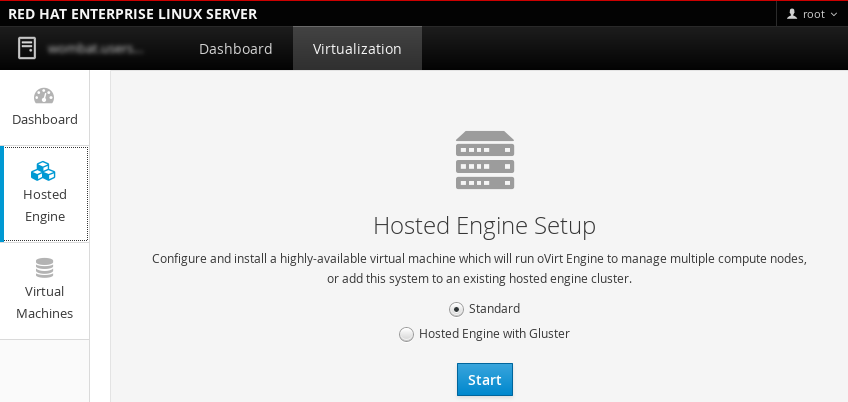Questo contenuto non è disponibile nella lingua selezionata.
2.2. Initiating Self-Hosted Engine Deployment on Red Hat Virtualization Host
On Red Hat Virtualization Host (RHVH), self-hosted engine deployment is performed through the Cockpit user interface. A UI version of the
hosted-engine script assists with configuring the host and Manager virtual machine. The script asks you a series of questions, and configures your environment based on your answers.
Prerequisites
- You must have a freshly installed Red Hat Virtualization Host system. The Performance Profile in the System sub-tab of the Cockpit user interface must be set to
virtual-host. - You must have prepared storage for your self-hosted engine environment. At least two storage domains are required:For more information on preparing storage for your deployment, see the Storage chapter of the Administration Guide.
- A shared storage domain dedicated to the Manager virtual machine. This domain is created during the self-hosted engine deployment, and must be at least 68 GB.
- A data storage domain for regular virtual machine data. This domain must be added to the self-hosted engine environment after the deployment is complete.
Warning
Red Hat strongly recommends that you have additional active data storage domains available in the same data center as the self-hosted engine environment.If you deploy the self-hosted engine in a data center with only one active data storage domain, and if that data storage domain is corrupted, you will be unable to add new data storage domains or to remove the corrupted data storage domain. You will have to redeploy the self-hosted engine.
Important
If you are using iSCSI storage, do not use the same iSCSI target for the shared storage domain and data storage domain. - You must have a fully qualified domain name prepared for your Manager and the host. Forward and reverse lookup records must both be set in the DNS.
- To use the RHV-M Virtual Appliance for the Manager installation, one directory must be at least 5 GB. The
hosted-enginescript first checks if/var/tmphas enough space to extract the appliance files. If not, you can specify a different directory or mount external storage. The VDSM user and KVM group must have read, write, and execute permissions on the directory.
Procedure 2.3. Initiating a RHVH-based Self-Hosted Engine
Initiating Self-Hosted Engine Deployment
Log in to the Cockpit user interface at https://HostIPorFQDN:9090 and navigate to Virtualization > Hosted Engine. Click .
Refer to Section 2.3, “Deploying the Self-Hosted Engine” for information about questions asked during the deployment process, and configuration information.
